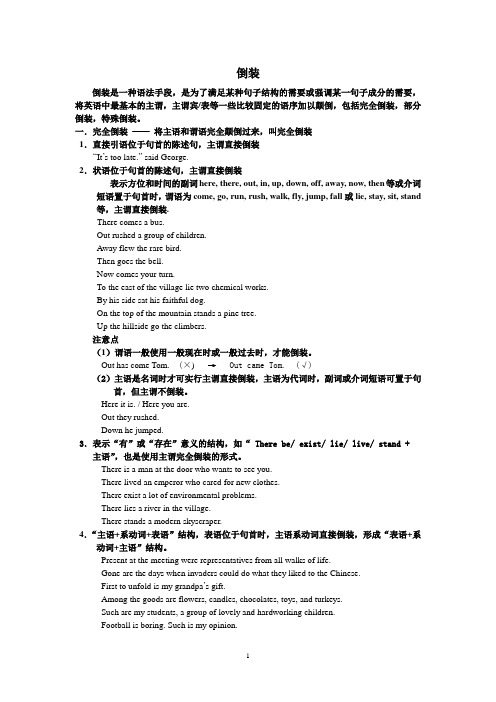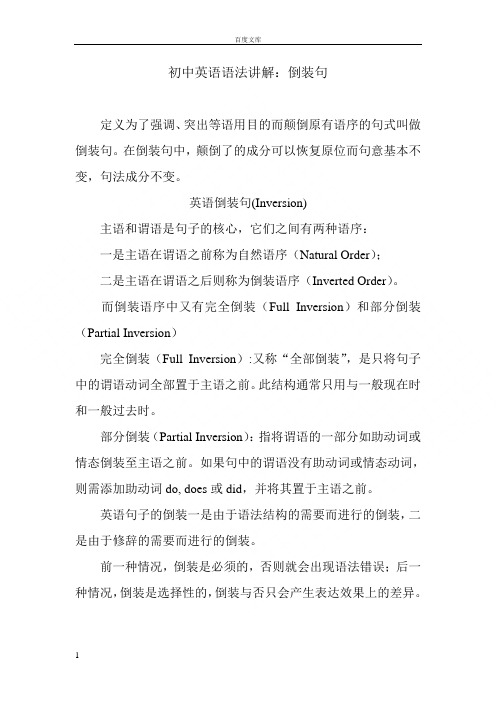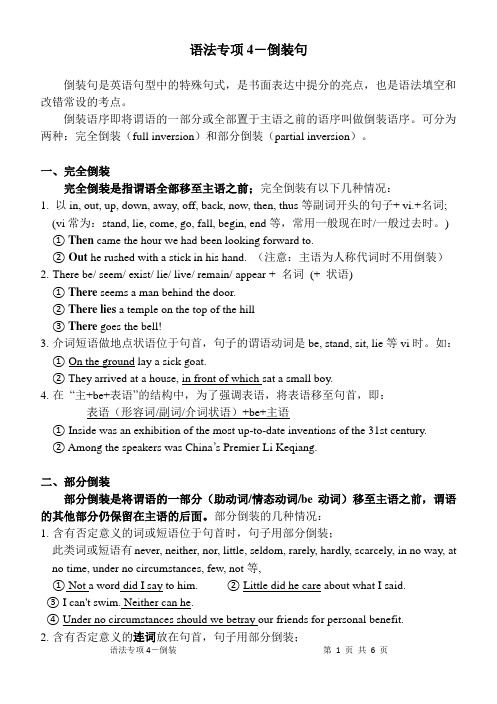语法第四次课讲解倒装
- 格式:ppt
- 大小:102.50 KB
- 文档页数:25


倒装倒装是一种语法手段,是为了满足某种句子结构的需要或强调某一句子成分的需要,将英语中最基本的主谓,主谓宾/表等一些比较固定的语序加以颠倒,包括完全倒装,部分倒装,特殊倒装。
一.完全倒装——将主语和谓语完全颠倒过来,叫完全倒装1.直接引语位于句首的陈述句,主谓直接倒装“It’s too late.” said George.2.状语位于句首的陈述句,主谓直接倒装表示方位和时间的副词here, there, out, in, up, down, off, away, now, then等或介词短语置于句首时,谓语为come, go, run, rush, walk, fly, jump, fall或lie, stay, sit, stand 等,主谓直接倒装.There comes a bus.Out rushed a group of children.Away flew the rare bird.Then goes the bell.Now comes your turn.To the east of the village lie two chemical works.By his side sat his faithful dog.On the top of the mountain stands a pine tree.Up the hillside go the climbers.注意点(1)谓语一般使用一般现在时或一般过去时,才能倒装。
Out has come Tom. (×) →Out came Tom. (√)(2)主语是名词时才可实行主谓直接倒装,主语为代词时,副词或介词短语可置于句首,但主谓不倒装。
Here it is. / Here you are.Out they rushed.Down he jumped.3.表示“有”或“存在”意义的结构,如“ There be/ exist/ lie/ live/ stand + 主语”,也是使用主谓完全倒装的形式。


什么时候需要倒装,什么时候部分倒装。
英语中有许多否定词和否定词组,在句中用作状语、宾语或表语,当它们被置于句首时,常常引起倒装。
在这些倒装句中,如果谓语动词是动词的一般现在时或一般过去时形式,句子需要全部倒装,否则就只局部倒装。
其他倒装情况要看具体强调的是什么内容。
常见的放句首的否定词有:(句型: 否定词+ 助动词/be动词+ 主语)by no means 决不in no case 决不in no way 决不on no consideration 决不under no circumstances 决不in nocircumstances 决不barely 简直没有hardly 几乎不scarcely 几乎不little/few 几乎没有,一点也不never 从不no sooner ...than...一...就not 不,没有not a bit 一点也不not...until...直到...才nowhere 没有地方,无处rarely 很少seldom 很少only 只有not only...but also 不但...而且...例句:Barely does he have enough time to study.By no means is translation work easy.注意:1. 这些倒装的词,只有当Not only…but also连接两个分句时,才在第一个分句用倒装结构。
如果置于句首的Not only… but also仅连接两个并列词语,不可用倒装结构,例如, Not only you but also I am fond of music.Not only did she refuse the gift,she also severely criticized the sender.2. 对于not…until句型,当not until…位于句首时,其后的主句要用倒装语序。

初中英语语法讲解:倒装句定义为了强调、突出等语用目的而颠倒原有语序的句式叫做倒装句。
在倒装句中,颠倒了的成分可以恢复原位而句意基本不变,句法成分不变。
英语倒装句(Inversion)主语和谓语是句子的核心,它们之间有两种语序:一是主语在谓语之前称为自然语序(Natural Order);二是主语在谓语之后则称为倒装语序(Inverted Order)。
而倒装语序中又有完全倒装(Full Inversion)和部分倒装(Partial Inversion)完全倒装(Full Inversion):又称“全部倒装”,是只将句子中的谓语动词全部置于主语之前。
此结构通常只用与一般现在时和一般过去时。
部分倒装(Partial Inversion):指将谓语的一部分如助动词或情态倒装至主语之前。
如果句中的谓语没有助动词或情态动词,则需添加助动词do, does或did,并将其置于主语之前。
英语句子的倒装一是由于语法结构的需要而进行的倒装,二是由于修辞的需要而进行的倒装。
前一种情况,倒装是必须的,否则就会出现语法错误;后一种情况,倒装是选择性的,倒装与否只会产生表达效果上的差异。
一、表示强调:倒装句最突出、最常见的修辞效果就是强调,其表现形式如下:1、only +状语或状语从句置于句首,句子用部分倒装。
例子:Only in this way can you solve this problem.只有用这种方法,你才可以解决这个问题。
Only after he had spoken out the word did he realize he had made a big mistake.只有当他已经说出那个字后才意识到自己犯了个大错误。
2、hardly、in no way、little、scarcely、seldom、never、no more、no longer、not、not only、no sooner、not only … (but also)、not until… 等具有否定意义的词或词组位于句首,句子用部分倒装。

语法专项4-倒装句倒装句是英语句型中的特殊句式,是书面表达中提分的亮点,也是语法填空和改错常设的考点。
倒装语序即将谓语的一部分或全部置于主语之前的语序叫做倒装语序。
可分为两种:完全倒装(full inversion)和部分倒装(partial inversion)。
一、完全倒装完全倒装是指谓语全部移至主语之前;完全倒装有以下几种情况:1. 以in, out, up, down, away, off, back, now, then, thus等副词开头的句子+ vi.+名词; (vi常为:stand, lie, come, go, fall, begin, end等,常用一般现在时/一般过去时。
)① Then came the hour we had been looking forward to.② Out he rushed with a stick in his hand. (注意:主语为人称代词时不用倒装)2.There be/ seem/ exist/ lie/ live/ remain/ appear + 名词(+ 状语)① There seems a man behind the door.② There lies a temple on the top of the hill③ There goes the bell!3.介词短语做地点状语位于句首,句子的谓语动词是be, stand, sit, lie等vi时。
如:① On the ground lay a sick goat.② They arrived at a house, in front of which sat a small boy.4.在“主+be+表语”的结构中,为了强调表语,将表语移至句首,即:表语(形容词/副词/介词状语)+be+主语① Inside was an exhibition of the most up-to-date inventions of the 31st century.② Among the speakers was China’s Premier Li Keqiang.二、部分倒装部分倒装是将谓语的一部分(助动词/情态动词/be动词)移至主语之前,谓语的其他部分仍保留在主语的后面。
倒装句倒装是需要表示一定句子结构和强调某一句子成分时所采取的一种句子手段。
注意我们经常总结的英语中的倒装主要是主谓结构的倒装,将主语和谓语完全颠倒过来为完全倒装,只将助动词或情态动词等移至主语之前,则称为部分倒装。
一、完全倒装1.表示地点,时间的副词放在句首时,句子需要完全倒装,此类副词常见的有:here, there, now, then, up, down, out等Eg. Here comes the bus.There stands an old tree.Now comes your turn.*注意如果主语是代词,则无需倒装,如第一个例句的主语不是bus而是it,则必须说:Here it comes.2.表示时间,地点,方向等的介词短语放句首时,完全倒装:Eg. In front of the village runs a river.On the top of the building flies a flag.3.分词短语置于句首时全部倒装:Eg. Lying on the floor was a boy aged about 12.Seated in the front were the guests.4.主系表结构中,表语前置,完全倒装:Eg. Present at the meeting were experts on biology.The lecture he prepared was long and boring. 可全倒装为:Long and boring was the lecture he prepared.5.There be句型为全部倒装。
二.部分倒装(半倒装)1.疑问句中的部分倒装:·一般疑问句中,我们都可以很明显的看到助动词或者be动词被提前到了主语前面:Have you finished your work?Do you like reading?-Are you crazy?·特殊疑问句中助动词也提至主语前,但要放在疑问词之后:Where did you live in the past?2.Only+状语/状语从句位于句首时,主句中的主语和谓语要部分倒装:Only+状语: Only in this way can you solve this problem.Only+状语从句: Only after you experience the same things will you understand your sister.3.表示否定意义的副词和连词放在句首时需要部分倒装结构。
大学英语四级CET4 语法讲义之倒装句一.概念:英语句子通常有两种语序:一种主语在前,谓语在后,称为自然语序,另一种谓语在前,主语在后,称为倒装语序。
二.相关知识点精讲按“主语+ 谓语” 这种顺序排列的句子是陈述语序。
如果排列顺序变为“谓语(或谓语一部分)+主语”,就是倒装。
倒装句分为:完全倒装:整个谓语移至主语前面叫完全倒装。
部分倒装:只把助动词、系动词或情态动词放在主语之前叫部分倒装。
1. 当以there, here, out , in , up , down, away 等副词开头的句子,为了起到强调的作用,可构成倒装句,只把副词放在句首,主语和谓语位置调换,不加助动词。
①Our teacher came in.②In came our teacher.(05.06阅读)Among the report are more outrageous(令人无法容忍的)findings - a German fertilizer described itself as "earthworm-friendly", a brand of flour said it was " non- polluting", and a British toilet paper claimed to be "environmentally friendlier".该报道当中,有很多让人无法忍受的发现,如:一种德国肥料被描绘成“对蚯蚓无害”;一种新的品牌的面粉写道“没有任何污染”;还有一家英国公司的卫生纸被宣称为“环保者”。
(07.06阅读)Then one day a few years ago, out of my mouth came a sentence that would eventually benete me reply to any and all provocations: I don't talk about that anymore.几年前的一天,我说了一句话并最终成为我对任何和全部挑衅的回答:关于那个问题我再也不讨论了。
第七节倒装、省略、比较结构和附加疑问句一、倒装(inversion)倒装句有两种形式:完全倒装(full inversion)和部分倒装(partial inversion)。
将整个谓语动词或整个谓语部分都放在主语前面时,称为完全倒装。
只将助动词置于主语前,谓语其余部分置于主语后,则是部分倒装。
1.完全倒装1)以here, there, now, then, from, out, down, in, up,away, on等副词开头的句子,且谓语动词表示位置转移的动态动词时。
2)地点状语置于句首,也会引起完全例装。
此类句中的谓语动词大多是表示走动或状态的不及物动词go, come, stand, sit, lie 等。
3)表语放在句首以加强语气时,主语要放在be动词之后形成完全倒装。
2.部分倒装1)表示否定或基本否定的词或者词组放在句首作状语时,通常句子要部分倒装。
这些词有:never, scarcely, hardly, rarely, little, now here, no sooner…than…, not only, in no case, in no way, on no account, at no time, under (in) no circumstances等。
2)句首为so, nor, neither等副词,表明前句说明的情况也适用于本句时,通常句子要部分倒装。
(注意:当so放在句首只是对对方所陈述的内容表示肯定时,不用倒装。
)3)Only引出的状语放在句首时,一般都是部分倒装。
(注意:only属于主语的一部分时,不可用倒装结构)。
4)As引导的让步状语从句用倒装结构,将表语或谓语中的动词提前。
系动词be前置用倒装结构,引导让步状语从句。
二、省略(Ellipse)1)在以if, when, though, although, as, as if等连词引导的从句中,如果从句的主语和主句的主语一致,且从句主要动词是be时,通常省略从句的主语和系动词。
高中英语语法---倒装句讲解主备人:林佳翠一. 倒装的含义在英语中,主语和谓语的语序通常是主语在前,谓语在后。
但有时为了强调句子的某一部分或其他原因,谓语需要全部或部分移到主语的前面,这种语序叫倒装三. 全部倒装全部倒装是只将句子中的谓语动词全部置于主语之前。
此结构通常只用于一般现在时和一般过去时。
常见的结构有:1)here, there, now, then, thus等副词置于句首, 谓语动词常用be, come, go, lie, run等表示来去或状态的动词。
例如:Then came the chairman. 那时总裁来了。
Here is your letter. 你的信。
Here comes the car 车来了2)表示运动方向的副词(如in, out, up, down, away, off, back等)作状语置于句首。
例如:Out rushed the students 学生们冲了出来Ahead sat an old woman. 前面坐着一个老人。
注意:上述全部倒装的句型结构的主语必须是名词,如果主语是人称代词则不能完全倒装。
例如:Here he comes. 他来了。
Away they went. 他们走开了。
3)表示地点的介词短语置于句首或强调地点概念时,此时主句的动词常为be, sit, live, lie, stand, rise, go, come 等。
例如:Between the two buildings stands a tall tree.On the ground lay a sick goat.4) 为强调表语,把表语置于句首时,或为保持句子平衡时。
例如:Gone are the days when women were looked down upon. Present at the meeting was Mr Liu, who taught us English.5) 表示祝愿的句子。